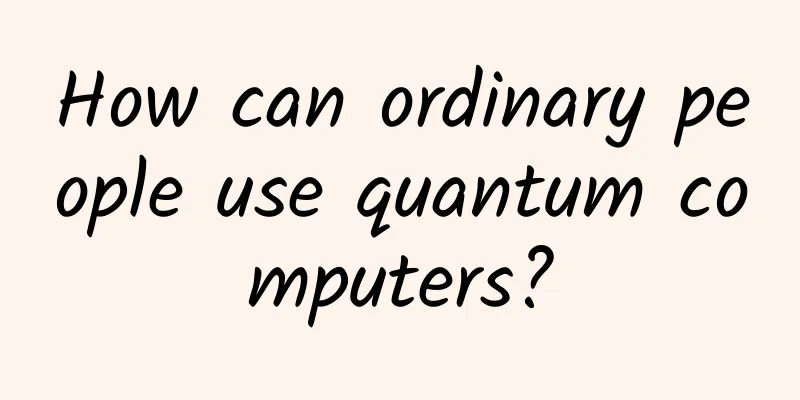How can ordinary people use quantum computers?

|
How can ordinary people get in touch with real quantum computers? The answer is "quantum cloud"; how can we Chinese get in touch with real quantum computers? The answer is "our own quantum cloud". Written by Wuxie (quantum computing practitioner) Recently, "quantum cloud" has become a hot word in technology. In May 2023, IBM launched the previously released 433-qubit "Osprey" processor on the quantum cloud platform; at the Zhongguancun Forum held in Beijing at the end of May, the Beijing Institute of Quantum Information Science (hereinafter referred to as "Beijing Quantum Institute") officially released the "Quafu" quantum computing cloud platform, which was jointly developed by Beijing Quantum Institute, Institute of Physics of the Chinese Academy of Sciences and Tsinghua University. The largest quantum computing system can provide 136 interconnected quantum bits that can be independently controlled and measured. Perhaps many people don’t know what “quantum cloud” is, or they easily associate it with cloud computing, but the two are actually two completely different things. Today we will talk about this highly-anticipated quantum computing power sharing model - quantum cloud. A superconducting quantum computing system What is quantum cloud? First, let's quickly introduce the difference between quantum computing and classical computing. The computing methods we use now, including computers, mobile phones, calculators, etc., are all based on binary logic. The lowest-level information storage and processing unit is called a bit. A bit can be in one of two states, 0 or 1. A large number of bits are connected together through circuits, and a series of logical operations are performed on them, such as "AND gate, NAND gate, XOR gate", etc., to finally obtain the state of the group of bits that store the calculation results, so that various operations can be performed. This method of computing is called classical computing. Here we see the four elements of computing: the first is the storage unit of information - the bit; the second is a set of universal logic gate operations acting on the bit; the third is the algorithm, that is, how the logic gates are organized and mapped to the bit; and the last element is reading. Quantum computing also needs these elements, and after using the basic principles of quantum mechanics such as superposition and entanglement, it can demonstrate many capabilities that classical computing does not have. The basic information processing unit of quantum computing is the qubit, which is the simplest quantum system - a two-level system. As an analogy, we can label the two energy levels as 0 and 1 respectively. Due to the superposition of quantum states, such a system can be in a superposition state of 0 and 1, that is, the qubit can be partially 0 and partially 1. This superposition property gives the qubit the ability to express multiple states at the same time, so it has a stronger information encoding ability. When multiple qubits are connected together, we can entangle them together, which is also a capability that classical bits do not have. It is difficult to explain the entanglement of quantum bits in detail, but we can understand it this way: in entangled bits, the expression of information must be viewed as a whole, and its dimension grows exponentially with the growth of the number of bits, which provides an exponentially growing coding space for calculations, and theoretically can achieve exponential computing acceleration capabilities. If we can find such a pair of energy levels (i.e. entangled quantum bits) and can continuously expand them, perform precise quantum gate operations on these quantum bits, and then accurately measure their quantum states, and finally design good quantum algorithms, we may be able to complete some incredible and efficient calculations. In fact, there is indeed an example - the famous Shor algorithm, which can reduce the complexity of large number decomposition problems to the quasi-polynomial level; in theory, this algorithm may crack the RSA password or elliptic curve password commonly used on the Internet in a very short time, and the threat level generated can be said to be directly related to national security. This is also one of the reasons why countries have invested heavily in the quantum computing/information industry. In reality, there are many physical systems that can construct quantum bits, which can be based on photons, electrons, atoms, molecules, atomic nuclei, lattice defects, etc. Readers who are familiar with quantum computing may have heard of superconducting quantum computing, ion trap quantum computing, semiconductor quantum computing, optical quantum computing, etc. These are essentially different technical routes developed based on different physical systems, and their progress is also different. At present, superconductivity and ion traps are considered to be the two most promising technical solutions. IBM's "Osprey" processor and Quafu quantum computing cloud platform are both based on superconducting solutions. Of course, whether it is a superconducting or ion trap solution, the (quantum) hardware developed by it is still in the application demonstration stage. The rapid development of the industry requires coordination between R&D and practical applications. On the one hand, there is an urgent need for the application side to put forward reasonable practical needs, so that developers can plan future research directions and technical routes more accurately; the application side also urgently needs to test and optimize its own algorithms on real quantum hardware to generate practical benefits as soon as possible. On the other hand, the technical threshold and capital investment of quantum computing are very high, and high-quality quantum computing resources are very scarce. Whether it is a university research institute engaged in theoretical research on quantum algorithms or an enterprise engaged in exploring quantum technology needs, it is difficult to obtain these quantum computing resources. Therefore, practitioners need an open sharing mechanism to closely connect the R&D end with the application end. At present, everyone thinks that the best way is the quantum cloud platform. P136 Quantum cloud performance and connectivity view (Source: http://quafu.baqis.ac.cn/) How to build a quantum cloud platform? If there is a finely calibrated quantum chip measurement and control system that opens a set of APIs to the Internet, we can access this quantum measurement and control system through the Internet, send quantum circuits to it and obtain the returned measurement data. If we can further provide a relatively complete set of tools and scheduling systems to help users compile and optimize quantum circuits, as well as bit mapping, and ensure that a large number of users can access it at the same time, we will have built a quantum cloud platform. It is necessary to understand what a "quantum measurement and control system" and "quantum circuit" are. In the previous article, we have roughly sorted out several elements of computing: information storage and processing units (bits), a complete set of universal logic gates, algorithms, and reading. The quantum measurement and control system is to solve the two links of physical realization of universal quantum gates and quantum state reading. The former corresponds to "control" and the latter corresponds to "measurement". Taking a single-bit rotating door as an example, if we want to rotate the state of a certain quantum bit QA 180 degrees around the X-axis, the actual operation is to apply a resonant microwave pulse with a precise area to QA. Such a pulse signal is generally edited and generated by a room temperature arbitrary wave generator, and the quantum bit is at an extremely low temperature. How can we accurately send this signal to the vicinity of the specified bit? This requires a cable to connect the pulse source to the control line of QA. This sounds simple, but it is very difficult to implement. Scientists and engineers not only need to ensure that there is enough signal to pass on, but also ensure that the room temperature heat is passed on as little as possible to ensure that thermal noise and other noise sources will not sneak along the cable to the vicinity of the quantum bit to cause damage. To this end, on the one hand, special low-temperature coaxial cables need to be used, and on the other hand, various attenuators, filters and other devices need to be inserted step by step. The entire link is very delicate. In terms of reading, we need to amplify the extremely weak quantum signal step by step and hand it over to the room temperature acquisition card for collection and processing. All these electronics, cables, various microwave devices, sample boxes, etc. used to achieve precise quantum gate control and accurate quantum state reading are the physical part of the complex and sophisticated "quantum measurement and control system". In addition, the software part of measurement and control is also very important. It is responsible for efficient management of measurement and control equipment, waveform control, data processing and visualization, as well as related tool chains, etc. Schematic diagram of quantum measurement and control system | Image source: IBM Quantum A quantum circuit is a logical sequence formed by organizing the above-mentioned quantum gates and readings for a specific purpose. The Shor algorithm mentioned above is essentially a quantum circuit. However, it is still relatively abstract and generally requires some conversion to run on an actual quantum computer, which requires the use of the quantum cloud's compilation optimization tools. On an open quantum cloud, users can submit a variety of quantum circuits as long as they comply with basic rules. This open nature makes the situations that quantum clouds have to deal with more complicated to some extent than conducting quantum experiments in the laboratory. You can imagine the following scenario: users can access real quantum computing resources directly through web pages and apps, and advanced users can even integrate them into their own applications to build their own quantum applications. All of this work can be done sitting in the office, without having to go to a quantum computing laboratory full of wires, and without having to build instruments and debug wires in person - this is a quantum cloud platform that can actually be used. It can be seen that the quantum cloud has greatly reduced the threshold for users to use quantum computing resources, allowing more people to quickly verify and improve their ideas on real quantum computers. Involving more smart brains is the ultimate shortcut to promote quantum computing towards practicality. Competition in quantum cloud is fierce, and independent research and development is the key The first to promote quantum computing in the form of quantum cloud was IBM. In 2016, they launched the first 5-qubit quantum cloud. To date, IBM has launched as many as 25 quantum cloud computing platforms, and the currently publicly accessible system contains up to 433 qubits. Since 2017, teams in my country have been exploring this model. The earliest one was the 12-bit quantum computing cloud platform launched by the Institute of Quantum Information and Quantum Technology Innovation of the Chinese Academy of Sciences. At present, many research institutions and enterprises have provided quantum cloud services to the outside world. The Quafu quantum cloud platform released at the Zhongguancun Forum this time is the first quantum cloud with a scale of more than 100 qubits in my country, and its significance is actually very great. Quantum computing with a scale of 100 qubits has greatly increased its complexity from chip design, ultra-low temperature circuit layout, measurement and control electronics integration, to measurement and control software system architecture. Combined with the higher-level compilation, optimization and cloud front-end software system design and testing, it can be said to be a systematic quantum engineering challenge. The United States currently has the most advanced quantum cloud technology, and the quantum application ecosystem based on it is also more in-depth. It should be noted that foreign quantum clouds have imposed great restrictions on China, and we have long been unable to access the best and most advanced quantum resources (China can only access IBM's earlier quantum cloud system with fewer bits). Therefore, domestically developed high-quality quantum cloud platforms are crucial to the development of my country's quantum computing technology and the construction of an industrial ecosystem. Finally, we should also realize that there is a gap between China and IBM in the layout of quantum cloud, and the construction of the quantum computing application ecosystem around quantum cloud has just started, and there is still a long way to go. Along the way, more scientists, engineers and entrepreneurs from different fields are needed to join hands and move forward together. I hope that my country's quantum computing technology can be steady and solid, with scientific research and industry advancing together, and move towards the top of the world on this subversive new track! This article is supported by the Science Popularization China Starry Sky Project Produced by: China Association for Science and Technology Department of Science Popularization Producer: China Science and Technology Press Co., Ltd., Beijing Zhongke Xinghe Culture Media Co., Ltd. Special Tips 1. Go to the "Featured Column" at the bottom of the menu of the "Fanpu" WeChat public account to read a series of popular science articles on different topics. 2. Fanpu provides a function to search articles by month. Follow the official account and reply with the four-digit year + month, such as "1903", to get the article index for March 2019, and so on. Copyright statement: Personal forwarding is welcome. Any form of media or organization is not allowed to reprint or excerpt without authorization. For reprint authorization, please contact the backstage of the "Fanpu" WeChat public account. |
<<: Can we follow the trend of using AI to fill in college applications?
Recommend
The ninth session of 360 Internet Technology Training Camp - Decoding and practice of 360 container technology
About this activity In recent years, container te...
Don’t eat hot pot, only choose Aion when buying a car. The first batch of Aion V owners in the southwest region have been delivered
On July 24, the 23rd Chengdu International Auto S...
Strange radio signals coming from the center of the Milky Way, are they sent by aliens? The truth is…
People's curiosity about aliens has never cea...
Sneak peek at the 618 e-commerce report: advertising increased by about 55% month-on-month, and major information flows have creative pictures!
For online shoppers, there are two opportunities ...
Cutting-edge practical experts: SEO trend prediction for 2016!
Search engine optimization has become one of the ...
Gaopengquan_Self-media Blue Ocean Transport Project Course Video
Gao Pengquan’s self-media blue ocean transfer pro...
Beijing has another "textbook-style epidemic prevention"! This time the building was not even closed!
May 2 Official WeChat Account of Xicheng District...
[Tutorial] How did a 16-year-old hacker install Windows 95 on a smartwatch?
Corbin Davenport, a 16-year-old hacker from Georg...
April Fools' Day marketing minefield, it will explode on the spot if you are not careful!
April Fool’s Day is coming soon. In this article,...
How much does it cost to customize a designated driver app in Zhaoqing?
The mini program provides convenience for publici...
How much does it cost to attract investment in the Bengbu Tea Mini Program? What is the investment price of Bengbu Tea Mini Program?
The overall investment promotion of Bengbu Tea Mi...
Apple "promotion", second-hand hardship
"I know that this time the government is off...
WeChat applet development practice - using UUID, Base64, Chance, etc.
[[173391]] UUID The node-uuid module can quickly ...
How much does it cost to attract investment for the Fuzhou Meat and Poultry Mini Program? What is the investment price for Fuzhou Meat and Poultry Mini Program?
Starting a business requires costs, and mini prog...
2015 Spring Festival Homecoming High-end App Recommendation
As a young man who was born in a small town and w...









